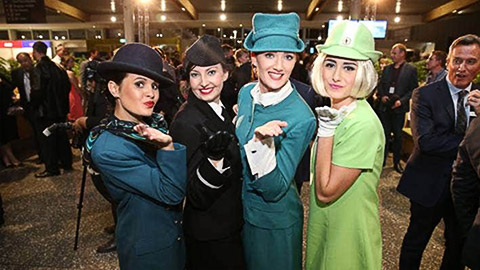Now that you understand some key components, other fundamentals are expected for good customer service delivery. There is often a more practical aspect that you can apply to the experience.
Practical fundamentals of customer service include:
- First impressions
- Building rapport
- Showing empathy
- Great communication skills
- Great product knowledge
- Personal presentation
- Customer feedback
- Building loyalty
- Staff training
- Complaint handling.
First Impressions
Providing excellent customer service starts well before a customer directly contacts workplace team members. There are many ways in which a company can create a first impression with a potential customer.
These include:
- Ease of access to information about the company’s products and services
- Ease of access to the company’s premises – parking, well signed, easy to find, clean, and tidy appearance from the outside and the inside
- Welcoming staff: sufficient staff on duty to cope with customer numbers, including telephone waiting times.
Building Rapport
Once a customer is in direct contact, building a relationship with that customer is crucial to customer service delivery.
Some ways in which an employee can build rapport with their customer include:
- Smile; use their name
- Ask questions about their planned use of a product or service
- Show an interest in them as a person, not just another opportunity to sell.
Empathy
Empathy has been defined as “The power of identifying oneself mentally with a person or object” or “Putting yourself in another person’s place and feeling as they would feel”.Source: Oxford English Dictionary
Examples of when empathy may be required in a tourism or travel situation can include:
- When airline passengers are facing a flight delay
- When a passenger’s bag has gone missing
- When a hotel is overbooked.
Empathy
The Emotion Airlines Wished All Their Flight Attendants Possessed, Yet’s So Hard To Come By
Forget fancy First Class suites or state-of-the-art in-flight entertainment systems. One thing significantly impacts the passenger experience more than all other touchpoints combined. You might not believe it, but it is, in fact, your Flight Attendant – the most significant cause of both passenger satisfaction and, conversely, dissatisfaction.
The one skill (or emotion) that airlines wish all their in-flight crew possess is empathy.
To understand precisely why airlines consider this skill so relevant, it’s essential first to understand what empathy is. Often wrongly confused with sympathy, empathy, in its simplest form, is the ability to put oneself, metaphorically speaking, in someone else's shoes.
Click on the following link to explore more.
https://www.paddleyourownkanoo.com/2018/02/15/empathy-emotion-airlines-wished-flight-attendants-possessed-yets-hard-come/Case Study
How to Empathise With Customers
In this article by Jeff Toister (11 May 2017), he describes a scenario about an airline passenger missing her flight.
The airline passenger was angry about missing her flight. It was her fault. She had been sitting at the bar a short distance from the gate and lost track of time. Those things happen in Las Vegas.
Our emotions often rise to protect our ego, so she looked for someone to blame. The first gate agent she talked to explained the airline's boarding policies and maintained that he had made several boarding announcements. It was a perfectly rational and reasonable explanation, but it wasn't the validation she wanted. So the passenger exploded—ranting, raving, and cursing.
Another gate agent calmly took her aside.
He listened patiently as she told her story. He didn't try to argue with her or make her feel stupid. The gate agent used the partner technique to shift his body language, which was non-adversarial. He listened.
He simply said, "I understand why you're angry. You shouldn't have to feel this way."
The passenger quickly calmed down and thanked him. She accepted an offer to get re-booked on a later flight.
The gate agent accomplished this minor service miracle through empathy.
Source: https://www.toistersolutions.com/blog/2017/5/2/how-to-empathize-with-customers
Empathy is a core skill in customer service. Customers often experience negative emotions. When that happens, the rational part of our brain can't control and function properly. Everything stops until those emotions cool down.
When you empathise with a customer, it makes the customer feel better. Notice the airline gate agent wasn't agreeing with the passenger. He didn't say, "You're right; we should have sent someone to find you in the bar." He communicated, "I understand how you feel, and it's okay to have those feelings." He then took steps to help her feel better.
Of course, this is what makes empathy so tricky.
How do you empathise with someone you can't relate to? Unless you've missed a flight because you've lost track of time in a bar at the Las Vegas airport, putting yourself in this woman's shoes feels like a stretch.
Important
There are three (3) steps to empathy. These are:
Step 1: Consider why the customer is irate. For the airline passenger, there were three issues. She was stressed about missing her flight and being inconvenienced by a delay. She was embarrassed that she caused the issue. And she was upset about the lack of empathy from the first gate agent.
Step 2: Think about a time you felt the same way. Imagine a situation where you were angry or embarrassed about something that was your fault. We've all done something stupid. It may not have been missing a flight, but it was something.
Step 3: Use that experience to identify with your customer's feelings. When we feel angry and embarrassed, the last thing we want to hear is it is our fault. (That's the mistake the first gate agent made.) We want someone to tell us they hear us, that we're not so dumb after all, and that they would be happy to help us fix it.
Great Communication Skills
Communication helps to create rapport, demonstrate empathy, and fully understand a customer’s needs. Communicating clearly with the customer is a cornerstone of customer service. Effective communication is the cornerstone of success in any industry, but it holds particular importance in the tourism sector. Tourism is a service-oriented industry that relies heavily on interactions with customers. Clear and concise communication is necessary to understand customer needs, provide accurate information, and deliver exceptional service.
Excellent communication is a two-way process that includes:
- Active listening
- Showing empathy
- Positive body language
- Clarification of customers’ needs or queries.
Explore
The following link is a great article that discusses the importance of good communication skills in a tourism career.
https://limbd.org/importance-of-good-communication-skills-in-a-tourism-career/
Watch this video
It is about how to communicate effectively at work. (10:57)
The Benefits of a Good Communicator
Being an excellent communicator not only helps you in your career but also in your daily life. Improving your communication skills can lead to more meaningful relationships, understanding, career success and productivity. Communicating efficiently ensures you understand your team members and their goals. It also can allow you to express your professional needs and emotions. Here are some essential factors to being an excellent communicator.
- Good listener. Communication usually requires two or more parties to be active in the conversation. Listening to others can help build relationships and ensure understanding. Actively listening when others are speaking or communicating with you can show that you respect them and allow you to learn more about the speaker or the subject of the conversation.
- Empathetic. Empathising with others can help you build trust and relationships in the workplace.
- Confident. Being confident in your communication can grow your credibility as a professional. It also can help you properly communicate your needs. Consider expanding your vocabulary and pausing whenever you are unsure what to say. This can help you remember your thoughts and speak clearly.
- Observant. Observing nonverbal communication, such as body language, is a very important aspect of communication. Recognising your customer's body language can give you insight into their feelings. It can also help you determine how they feel about your demeanour. For example, if you're having a casual conversation with someone who seems relaxed, your demeanour is probably also relaxed. Being purposeful in your communications, including body language, can help others understand your needs and intentions.
- Polite. Being polite in your written, verbal and nonverbal communication can ensure clear intentions. Consider kindly greeting others when starting conversations, actively listening and using good manners when interacting. This can also establish an excellent reputation and invite others to treat you politely as well.
- Respectful. Showing respect during your communications involves being polite and attentive. Allow them to finish speaking before replying to convey your respect for someone you are speaking with. Actively listening to another can also show that you respect them and their point of view. When listening to others, consider their words and what they mean to see if you can apply them to your response.
- Honest. Great communicators are often dedicated to being honest. This practice can earn you a positive reputation and ensure accurate workplace communication.
- Proactive. Skilled communicators address conflicts promptly and start a conversation when needed. Being a proactive communicator can help prevent misunderstandings and establish a responsible reputation.
- Reflective. Self-reflection is an essential aspect of communication. It allows you to think thoroughly before speaking, ensuring you are clearly and intentionally communicating. Being reflective can also encourage you to consider how your words and body language might make others feel. Try to recognise the outcomes of how you react to others and your feelings. Being conscious of this can help you adopt better communication practices.
Great Product Knowledge
Knowing the product and discussing features and benefits with customers confidently reassures them that their needs are being understood and met. It helps build trust between you and your customers, creates more positive customer service experiences, and allows agents to provide accurate and helpful product information. Product knowledge is critical to increasing sales. The more you know about the travel products you are selling, the more comfortable you will be suggesting them to your customers. When employees interact with customers, it allows them to demonstrate their product knowledge and inform customers how a product can provide them with more significant benefits than an offering from a competitor. This shows that employees understand prospective clients' needs while making a lasting, positive impression.
Source: https://www.indeed.com/career-advice/career-development/products-knowledge
Product knowledge can benefit a company:
- When employees have a solid understanding of each product, it's easier to answer customers' questions and provide them with factual information regarding the products. It also allows employees to focus on the benefits the products provide. Customers can make more informed decisions about what to buy when they receive accurate product information.
- If employees understand the products they're selling and show their passion for them, customers may respond more positively to such enthusiasm. In addition, this knowledge and eagerness to share the product's benefits may sway a customer to be ready to purchase. Understanding benefits allows an employee to reflect on the positive aspects of a product honestly.
- Providing customers with accurate product information helps them view company employees as trustworthy sources of information. Employees providing product information that aligns with what customers read online helps build trust. Establishing trust increases the chance of customers making a purchase.
- When employees interact with customers, it allows them to demonstrate their product knowledge and inform customers how a product can provide more significant benefits than a competitor's offering. This shows that employees understand prospective clients' needs while making a lasting, positive impression. When customers sense the seller cares about providing a pleasant, beneficial customer buying experience, they may be more apt to remember the company fondly and become repeat customers.
Important
Click on the following link to download a PDF of an article by Steve Gillick entitled "Six Ways to Master Product Knowledge and Why It's Important".
Reflection
Consider an example of when you have been a customer assisted by someone with excellent product knowledge. How did you feel?

Watch this video
Learn how to make a great first impression. (1:48)
Personal presentation is how you present yourself in everyday situations. This communication skill is essential in gaining employment and being part of a workplace environment. What you say and do is part of your presentation and outward appearance.
A first impression is made within five seconds of meeting someone. In those five seconds, you have classed the person before you. You will have summed your impression of them by how they present themselves. The term ‘easy to make, hard to break’ aptly applies here!
We all have prejudices that affect us individually. You may not, for example, like tattoos or facial piercings. Should you be presented with someone like this, you will immediately put them in a compartment in your mind. This may be a young and trendy person so that they will be updated with things. It may be, ‘Oh no, that person won’t know what I want’.
Either way, perceptions are necessary, or your presentation will immediately affect how you are received. Before embarking down this road, a question to ask is, “What impression do I want to make?” then dress and present yourself accordingly.
Personal appearance in the workplace
Reflection
Consider what personal presentation tips you would give a person starting in a customer service role in a tourism or travel workplace.
Air New Zealand is revamping its grooming rules for cabin crew: What could change?

Image source: https://www.stuff.co.nz/travel/news/131919735/air-new-zealand-is-revamping-its-grooming-rules-for-cabin-crew-what-could-change
Flight attendants have long been subject to strict grooming requirements to ensure they look fresh and polished at all times – but in recent years, some airlines have been rewriting the rulebooks.
Air New Zealand has said it will be revising its grooming standards as it begins the hunt for a designer to create a new uniform for its pilots, flight attendants and ground staff.
Reading
Read more about this at the following link.
Gathering and Using Customer Feedback
Customer feedback is essential in developing and refining customer service delivery.
Customer feedback gives you insight into customer satisfaction levels. Customer satisfaction is how happy customers are with your products, services, and any interaction with your business. It's an important metric as it helps you address customer issues, prevent churn, and build a base of loyal customers.
Here are some ways a tourism or travel workplace can obtain meaningful customer feedback:
- Surveys
- Comment forms
- Feedback link on the website
- Monitoring complaints and compliments.
Here are some ways a company can use customer feedback to enhance customer service:
- Provide additional training where necessary
- Develop or introduce products or services that meet customer demand
- Have an adequately developed complaints resolution process
Explore
To find out more – click on the following link.
Customers are already giving feedback - to friends, family competitors, social media, etc. So the question becomes, are you going to start listening to feedback and implement change because of it?Katie Cort - Senior Channel Consultant, Hubspot
How does NZST gather feedback from their students and staff?
Students:
- Mid and end-of-year surveys
- Module surveys
- Q-time.
Staff:
- Bi-annual staff feedback surveys.
Building Loyalty and Generating Referrals
A vital component to the success of any business is to create repeat business from existing customers and to use their loyalty as “brand ambassadors” to generate new customers through word-of-mouth referrals. It is much easier and cost-effective for a company to retain existing customers than to gain new ones. Customer loyalty happens when customers give a company repeat business over time. If you provide great value in your product or service, and the customer experience stays consistently good, then your business will reap the benefits of customer retention.
Here are some ways a company can build loyalty amongst existing customers:
- Have a loyalty programme that provides rewards
- After-sales follow-up
- Creating a database and using direct mail for special offers
- Communicate your company values
- Provide exceptional customer service
- Ask for feedback.
Companies with Excellent Brand Loyalty
Let’s look at a few quick examples of companies with famously high customer loyalty – and explore how they nurtured it.
Apple

Apple routinely tops brand loyalty charts, and 2021 saw the company reach an all-time brand loyalty score of 92%. People who buy Apple products tend to keep buying Apple products, and there are lots of reasons why. Image is a crucial driver for Apple, with its products firmly positioning itself as high-value, aspirational products that are an apparent league above the competition. This works in tandem with a well-maintained company story that Apple is for people who “think different” and an origin that gave it innate underdog status against rival Microsoft.
But arguably, the most critical factor in its brand loyalty success is a focus on excellent customer service. The company continually tops customer satisfaction indexes in the 80s yearly (across the smartphone and computer segments) thanks to famously forgiving and robust repair programs and in-store excellence.
NIKE

Like Apple, Nike’s brand loyalty success has been built on a bedrock of aspirational, motivational image building. Nike uses famous athletes as brand ambassadors to significant effect, but in recent years a lot of Nike’s brand loyalty efforts have been focussed on the omnichannel customer experience as a way to foster a sense of both community and exclusivity.
Through a collection of free apps (Nike Run Club, Nike Training Club, etc.), customers are incentivised to create an account that offers priority tickets to events, exclusive deals, free training advice/programs, and community features. This ecosystem works to build brand-loyal customers who see Nike as their first choice for all things sports.
Starbucks

In 2020, Starbucks reported that its Starbucks Rewards loyalty program had crossed 19.3 million members, growing by 10% YoY despite the global pandemic causing a dip in overall transactions. Globally, this loyalty scheme is now responsible for almost 50% of the company’s total sales and stands as a fantastic example of customer loyalty being rewarded with natural intelligence.
Starbucks Rewards uses in-app user data, specific store insights, and purchase history to build out offers and discounts that feel unique and personalised to each customer.
Explore
Some loyalty programmes include:
- Air New Zealand – Airpoints and Koru Club - https://www.airnewzealand.co.nz/airpoints
- ACCOR - https://all.accor.com/loyalty-program/reasonstojoin/index.en.shtml
- AVIS - https://www.avis.co.nz/en/loyalty-profile/avis-preferred
- Carnival Cruises - VIFP Club - https://www.carnival.com/vifp/benefits
- HILTON Hotel – Hilton Honors - https://www.hilton.com/en/hilton-honors/
Reflection
Do you belong to any loyalty programmes?
Which ones and why?
Are the benefits worth it?
Staff Training
Ensuring that staff are well trained is one of the most essential strategies in providing excellent customer service. It should begin with the induction of new employees and continue as the trading environment and product range change.
The training you would provide for staff in your tourism or travel workplace includes:
- Customer service skills training, e.g., PDT or Tourism IQ
- Telephone skills
- Product knowledge
- Complaint handling skills.
Complaint Handling
Even companies with the best levels of customer service have occasions when a customer is disappointed, or the delivery of service falls below what the customer expects or is used to. In these situations, the company must have a process to deal with customer complaints.
Some good strategies for a company to have when dealing with complaints include:
- Handle complaints promptly
- Train staff in complaint-handling procedures
- Ensure the customer understands the complaint procedure
- Follow up with the customer
- Record complaints and track trends.
Customer Expectations
Customers have expectations about how they will receive goods or services. If you are going to give a service described as exceptionally good, you need to identify your customers’ expectations and not only meet but exceed them.
As customers ourselves, we would expect:
- Timeliness – we know when we want things to happen
- Quality – we know how good the service should be
- Courtesy – we know how we want to be treated.
Learning Activity
Fast Food Outlet
Imagine you are a customer in a fast-food outlet and getting a meal for your friends or family. Complete the following table in the attached Word document, complete it and post your responses to the Forum, Fast Food Outlet.
Download your Word document here.
(There are no right or wrong answers – we seek your viewpoints).
| What are your expectations regarding the time it can take for you and your family to be served? | |
| What quality of food and drink do you expect? | |
| What quality of service do you expect? | |
| What standards do you expect regarding the eating area and tables? | |
| How do you expect to be treated by staff? |
Enhancing Customer Service
Turn the cards to explore strategies for enhancing customer service.
Learning Activity
New Zealand Coach Company
Imagine you are a New Zealand Coach Tour company tour leader for this exercise. Complete the table in the attached Word document in the Forum, New Zealand Coach Company, describing how you would feel in each of the following situations.
Click here to download the Word document.
(Share your opinions with your online peers. Each answer is valid).
Learning Activity
The Importance of Customer Service
Answer the following questions.
- Why is the customer service provided to external customers by you and others important to your employer?
- What might the effects be on your employer’s business if external customers were dissatisfied with the service they received?
- What impression might external customers gain of a company whose employees take great pride in their appearance?
- Why might external customers decide the sort of company you work for based on how you act and appear?
- Why must you provide excellent customer service for your internal customers?
- What do we mean when we talk about reliable customer service?
- How can you ensure your customers do not suffer when you are having a bad day?
Post your responses to these questions and upload them to the Forum, The Importance of Customer Service.

To be able to evaluate the customer service being provided in a tourism or travel workplace, there needs to be some criteria established against which the service levels can be measured. Reflecting on the critical components of customer service that we studied earlier in the module and using them as the basis for an evaluation system.
We looked at the five components, which are:
- Tangibility
- Reliability
- Responsiveness
- Accuracy
- Empathy.
How can we use these components to create evaluation criteria? Firstly, we need to decide on the method of evaluation. Some of the ways a customer service evaluation can be conducted are:
- Telephone survey
- Mystery shopping
- Direct experience
- Customer exit surveys.
Mystery Shopping
A mystery shopper plays a vital role in assessing and evaluating various aspects of a business. Their primary objective is to gather insights into the customer experience by posing as a regular customer. It is someone who visits a location assigned to them and acts like a regular customer to observe and evaluate several different areas such as store presentation, customer service, selling skills and product quality. It is an effective tool that businesses use to gain insight into employee training areas needing improvement. Through discreetly observing employees in their daily tasks, mystery shoppers can identify potential issues like customer service, product knowledge, and overall attitude.
Reading
Read the following online article on how mystery shoppers work:
https://www.stuff.co.nz/business/88704836/get-paid-to-shop-till-you-drop--mystery-shopping-grows
A list of customer criteria for evaluation needs to be created to enable an evaluation, which covers the five key components.
Using the five characteristics of Servqual, we have created a list of questions you could use for a telephone survey or in person for any Tourism and Travel workplace. Each question has been itemised under the five headings it relates to. We have also considered how to grade each question. Is it a straight ‘yes/no’ answer or a question ranging from 1(not good) to 5 (the best)?
Questions:
Tangibles
| Was printed and visual material available in advance and easy to access? | 1 2 3 4 5 |
| Was the location of the tourism activity easy to find? | 1 2 3 4 5 |
| How would you rate the appearance of the facility from the outside? | 1 2 3 4 5 |
| Were the facilities provided clean and well-maintained? | 1 2 3 4 5 |
| Were the staff well groomed? | 1 2 3 4 5 |
Reliability
| Is the facility open at hours that would meet the needs of tourists? | 1 2 3 4 5 |
| Was the experience of the tourism facility comparable to prior expectations? | 1 2 3 4 5 |
| Did staff provide the service consistently? | 1 2 3 4 5 |
Responsiveness
| Were staff available to answer customer queries? | 1 2 3 4 5 |
| Were staff knowledgeable and efficient when dealing with customers? | 1 2 3 4 5 |
| Were staff willing to go the extra mile to meet customers’ needs? | 1 2 3 4 5 |
| Did the staff make customers feel valued? | 1 2 3 4 5 |
Assurance
| Did staff encountered appear to be well trained in their role? | 1 2 3 4 5 |
| Did staff demonstrate excellent product knowledge? | 1 2 3 4 5 |
| Did staff demonstrate good listening skills? | 1 2 3 4 5 |
| Did staff communicate effectively in response to customer requests? | 1 2 3 4 5 |
| Did staff represent their organisation well? | 1 2 3 4 5 |
Empathy
| Did staff appear to treat customers as individuals? | 1 2 3 4 5 |
| Did the organisation provide a means of gathering customer feedback? | 1 2 3 4 5 |
| Was there a readily identifiable and easily understood complaints procedure? | 1 2 3 4 5 |
Learning Activity
Telephone Survey
Consider a list of questions you could use for a Cafe or Restaurant telephone survey. Think about:
- Menus
- Location of business
- Facilities
- Opening hours
- Customer service
- Knowledge
- Impressions of staff.
Each question should be itemised under the five headings it relates to. These are:
- Tangibility
- Reliability
- Responsiveness
- Assurance
- Empathy.
(For example, under Tangibility, you may ask, “How would you rate the restaurant's appearance from the outside?”)
You will also need to consider how to grade it. Is it a straight ‘yes/no’ answer? Do you range the question from 1 (not good) to 5 (the best), etc.?
Create a Word document that details the questions you would need to ask a restaurant customer over the telephone and how you would grade each question. Post your document to the Forum, Telephone Survey.
How to Evaluate Customer Service
In-person, visit a café or restaurant over the next week. When surveying for real, you must understand the need to be respectful and discreet. Once done you can complete this next Learning Activity.
Learning Activity
Evaluation Checklist Test Drive
Using your completed checklist, provide an overall written evaluation of the quality of service for the establishment. This will include the name of the establishment, identification of the positive and negative aspects of customer service in terms of the workplace’s ability to meet your established evaluation criteria and the five (5) dimensions. Write a final statement that includes an overview of the establishment, the overall customer service experience, and evaluation results.
Create a Word document that details the checklist of your individual customer service questions.
Post your document to the Forum, Evaluation Checklist Test Drive.
Example: Sea Life Aquarium Kelly Tarltons
Explore
Using the following link, explore the Sea Life website.
Positive Aspects of Customer Service
- Tangibles - Kelly Tarltons scored highly for easy access to printed and visual material. The company website is comprehensive and easy to use. On-site, there were printed brochures displaying various displays at the aquarium.
- Reliability - Kelly Tarltons is open from 9.30 am until 5.30 pm every day, including public holidays
- Responsiveness - Staff were well informed and were able to answer questions across a range of topics related to the aquarium
- Assurance - Staff were very knowledgeable about all aspects of the aquarium and the marine animals on display
- Empathy - Staff at Kelly Tarlton’s are selected for their ability to relate well to customers.
Negative Aspects of Customer Service
-
Tangibles - The exterior paintwork and signage look dated
-
Reliability - Although the aquarium is open daily, the last time for entry is 4.00 pm. This time is relatively early given the long hours of daylight in the peak summer season when evening visits might be attractive to some visitors
- Responsiveness - There were no negative responsiveness issues
- Assurance - There were no assurance issues
- Empathy - Although a customer response form is available upon departure, it was not visible.
Final Statement
Kelly Tarlton's Sea Life Aquarium is a public aquarium opened in 1985 in Auckland. It is home to thousands of marine life, including penguins, sharks, stingrays, and octopuses. The overall customer service experience at Kelly Tarlton’s was very good. Despite the facility's rather tired and worn look, the aquarium is still fascinating. The enthusiastic, knowledgeable service provided by the staff adds to the experience. Given the evaluation results, it is considered that Kelly Tarlton’s Sea Life Aquarium provides a quality tourism experience.
Exceeding Customer's Expectations
If customer service is an organisation’s ability to meet its customers’ wants and needs, then excellent customer service is the ability of an organisation to exceed the customers’ expectations constantly and consistently. Suppose our goal is to exceed customer expectations. In that case, we must recognise that every aspect of our business impacts customer service, not just those aspects that involve face-to-face customer contact. Improving customer service involves learning customers' needs and wants and developing action plans implementing customer-friendly processes.
For example:
- Providing excellent customer service is one way a small business can distinguish itself from the competition.
- Improving customer service involves committing to learning customer’s needs and wants and developing action plans to meet those needs.
Case Study: Moments of Truth

In 1981, Jan Carlzon became the Chief Executive Officer of the Scandinavian Airlines System (SAS). The airline was deeply in debt and had a performance record rating of 14th out of 17 European airlines. Mr Carlzon set about reviving the airline’s fortunes by introducing a radically different customer service approach that included, among other things, empowering employees to make decisions on the spot without spending time consulting superiors for permission. Carlzon recognised that when front-line employees interact with customers, the whole airline is being judged, and these daily interactions are crucial to the success or failure of the company. Within one year under Carlzon’s leadership, SAS posted its first profit in several years and had the best on-time performance record in Europe.
According to Jan Carlzon, every time you have contact with a customer, it is “A Moment of Truth”. Each connection is a time when the customer places a value on the service provided by your company. Contact does not always have to be with a staff member – it may be with a process or product, e.g., rental car lights or hotel air conditioning. At every time of contact, your company will be judged.
Shining moments of truth leave the customer feeling positive, enthusiastic, pleasantly surprised and satisfied with the customer service. Dull moments of truth leave the customer feeling negative, unpleasantly surprised, and therefore dissatisfied with the customer service. It takes twelve positive moments of truth to overcome one negative moment of truth.
Empowering staff to make customer service decisions makes positive moments of truth more likely. Reach out to people in ways that are important to them, and they will:
- Like your product
- Tell their friends
- Use it again
- Become loyal customers
- Even become advocates of your product or service.
Source: Moments of Truth by Jan Carlzon
Communication between individuals is a process based on transmitting ideas and responses from one person to another. The communication process refers to a series of actions or steps to communicate successfully. It involves several components, such as the sender of the communication, the actual message being sent, the encoding of the message, the receiver and the decoding of the message. There are also various channels of communication to consider within the communication process. This refers to the way a message is sent. This can be through various mediums such as voice, audio, video, writing email, or body language. The overall goal of the communication process is to present an individual or party with information and have them understand it. The sender must choose the most appropriate medium for the communication process to work successfully.
Parts of the Communication Process
The communication process has several components that enable the transmission of a message. Here are the various parts:
- Sender: This is the person that is delivering a message to a recipient
- Message: This refers to the information the sender relays to the receiver
- Channel of communication: This is the transmission or message delivery method
- Decoding: This is the interpretation of the message. The receiver performs decoding
- Receiver: The receiver is the person who is getting or receiving the message
- Feedback: Sometimes, the receiver might receive a response from the sender. This starts an interaction.
How does the Communication Process Work?
To successfully communicate, it's essential to understand how the process works. Here are the seven steps in the communication process:
- The sender develops an idea to be sent - the beginning of the communication process involves the sender creating an idea they plan to send to another person or group. Essentially, they plan the overall subject matter or information they want to transmit.
- The sender encodes the message - once the sender develops an idea, they translate it into a form that can be transmitted to someone else. This means they transform the thoughts of the information they want to send into a specific format. For example, if you are writing a letter, you'll translate your idea into words. The message can also be nonverbal, oral or symbolic.
- The sender selects the channel of communication that will be used - next, the sender decides how the message will be sent. This involves selecting the most suitable medium for the message they're relaying. Some communication mediums include speaking, writing, electronic transmission or nonverbal communication. Select the most professional communication channel if you're communicating at work.
- The message travels over the communication channel - after the medium is chosen, the message begins the transmission process. The exact process of this will depend on the selected medium. The sender should have selected the appropriate medium for the message to be correctly sent.
- The receiver receives the message - next, the message is received by the recipient. This step in the communication process is done by hearing the message, seeing it, feeling it or another form of reception.
- The receiver decodes the message and then decodes the sender's message. In other words, they interpret it and convert it into a thought. After this, they analyse the message and attempt to understand it. The communication process is performed effectively when the sender and receiver have the same meaning for the transmitted message.
- The receiver provides feedback, if applicable - lastly, unless it's a one-way communication, the receiver will provide feedback in the form of a reply to the message's original sender. Feedback allows the recipient to ensure the sender that their message was received correctly and interpreted. Between two people, this is two-way communication.
Source: https://www.indeed.com/career-advice/career-development/communication-process
However, at each stage of the transmission process, there is potential for interference. This is sometimes referred to as “noise” that gets in the way of the transmission and leads to misunderstanding or misinterpretation of the message. This interference can come in many forms, such as another conversation going on simultaneously, distraction caused by something happening around the sender or receiver, ambiguity in the message, actual noise interfering with the receipt of the message, and so on.
For communication to be successful, each communicator needs to be fully “tuned in” to the process to avoid misunderstanding and misinterpretation. Minimising interference and focusing on the communication process is the best means of ensuring successful communication.
Body Language

Body language uses physical behaviour, expressions, and mannerisms to communicate non-verbally. Body language is the unspoken part of communication that we use to reveal our true feelings and to give our message more impact.
Important
The following statistics illustrate the impact of positive body language:
- 55% of what we learn from someone is gained from their body language
- 38% is from their tone of voice
- 7% is from their words.
A simple example of body language is a relaxed facial expression that breaks out into a genuine smile – with mouth upturned and eyes wrinkled. Equally, it can be a head tilt that shows you're thinking, an upright stance to convey interest, or hand and arm movements to demonstrate directions. Eye-to-eye contact is a powerful and effective “listening” tool. It shows interest, attention and understanding. It helps you assess the feelings of the customer. However, there are cultural differences as to how eye contact is perceived, and it is essential to avoid overdoing it. Too much eye contact can give the impression of staring. Being aware of body language in others means that you can pick up on unspoken emotions and reactions. It’s a valuable form of feedback, but it can easily be missed if you’re unaware of what to look for.
Gestures that are used for emphasis include:
- Open palm gestures rather than closed fists and pointing
- Nod to indicate understanding and empathy
- Lean forward slightly to communicate your interest
- Personal space of 2-4 feet is the most comfortable for most people.
It is okay to get closer if someone, for example, is demonstrating a product or reading a brochure. Sitting and using a table or desk can be more comfortable. Mirroring the customer’s posture and gestures indicates empathy. Care is needed, however, not to overdo it and appear to be mocking the customer.
Things to avoid using in body language include:
- Folding your arms
- Standing over customers
- Sitting while the customer stands
- Talking behind your hand
- Getting too close to a person, invading their personal space
- Using barriers to stand behind or leaning against something
- Watching something else happening in the room.
Explore
For more examples, read: 22 Body Language Examples And What They Show About People at the following link.
https://www.betterhelp.com/advice/body-language/22-body-language-examples-and-what-they-show/
Watch this video
It is about the importance of body language. (2:10)
Questioning Skills
You use open and closed questioning when you ask questions to determine your customers’ needs and wants.
- Open questions gather information about the customer’s requirements
- Closed questions clarify something with a ‘yes’ or ‘no’ answer.
Closed questions are used to clarify or obtain one piece of information. Some closed-question examples are:
- Can I help you?
- Is this a convenient time for you to talk?
- Will you be travelling alone?
Each type of question has its place but needs to be used at the appropriate time. Open questions start with the following:
- How
- Where
- What
- When
- Which
- Who
- Why
They are used in seeking information. Some open-question examples include:
- How does that fit with your programme?
- Which is the best option for you?
- When do you need this?
Learning Activity
Open Questions
You are a Travel Consultant with Flight Centre. A customer comes into your office. What open questions can you ask this new customer to seek information on their travel needs: Use all 7 open question starters:
- How
- Where
- What
- When
- Which
- Who
- Why
Post your responses to the Forum, Open Questions.
Handling Customer Complaints

The ability to LISTEN to a customer is often regarded as the most critical skill in customer service delivery. Similarly, research has shown that customers who have had a bad service experience list the wish that someone had just listened to them as their number one customer service complaint remedy.
- The priority is to let the customer speak. Use active listening skills to reassure the customer that you are attentive to what they are saying. Listening involves more than just hearing their story; it is also about recognising signals and indicators of what is behind the story. Sometimes, the real problem is not explicitly outlined. Listening to a customer can provide helpful insights to improve systems or service issues that benefit others.
- Allow the customer to finish venting. This allows them room to listen to you. When the customer has finished speaking, move to the next step.
- Paraphrase their concerns. Rephrase it in your own words to ensure you have understood the issue correctly. This shows them that you are listening. For example, ‘So what you are saying is that your hamburger was raw and that you felt sick because of it’. Take notes if necessary to ensure you have understood all the essential points.
- It is essential to remain calm even if the customer is angry at you. When responding to them, use a softer tone than the customer. This will have the effect of lowering their tone as well.
- Invite the customer to sit down with you. If possible, move them away from public areas so you don’t have an audience of onlookers who may become drawn into the discussion. Avoid barriers such as desks or counters when sitting with an angry customer. Sitting at right angles to them makes it less confrontational than face-to-face.
- Do not prejudge the situation – the customer is complaining for a reason.
- Acknowledge the hurt and take possession of the problem. For example, “I can see how disappointing that must have been. I will do what I can to sort this out for you.”
- Be transparent about the solution process. If you cannot solve the problem (due to lack of authority or knowledge), make a commitment that the customer will understand. For example, who, how, when – who the appropriate person is to deal with the problem; how they will contact the customer; when the customer can expect to be contacted. Always follow up with the person to whom you have referred the complaint to ensure that they have been in touch with the customer by the time you indicated. Remind them that the customer is waiting to hear from them if necessary.
Don't presume a customer complaint is a negative experience because, if handled well, it can be a valuable learning tool. It may also result in a loyal customer. An effective complaint-handling system needs someone in the company to drive it and take ultimate responsibility. The company can benefit in several ways, including:
- Improved product quality and service delivery
- Fewer mistakes and less time spent fixing them
- Better understanding of customer needs
- Greater customer loyalty
- More customers through word-of-mouth advertising from satisfied clients
- Less time and money spent attracting customers
- Improved business reputation
- A healthier bottom line.
Record Keeping
Keeping records of customer complaints can be a valuable management resource. The following procedures are good practice when dealing with complaints:
- Customer correspondence needs to be recorded and tracked
- Telephone logs of complaints need to be kept
- Staff should take notes during conversations
- Statistics on the number of complaints received and their method of resolution should be kept
- Comparison by month/quarter/year should be made
- Staff should be included in the review process
- Treat each complaint as an opportunity to learn
- Compliments should also be logged and shared with staff
- Surveys are a valuable way of measuring customer service performance
- Feedback should be recorded and compared.
Key Points for Complaints Procedures
The following points are resourceful in facilitating the company’s complaints procedures:
- Handle complaints immediately
- Train staff to handle complaints well
- Ensure the complaints procedure is easy for the customer
- Stay in touch with the customer. If the information does not arrive by the promised time, tell them!
- Send a follow-up message or small gift once the issue has been resolved
- Keep records and use the information to assist in staff development and procedures.
Emotional Quotient or Intelligence
Emotional Quotient (or EQ) is the emotional understanding and capability of oneself and others that help with differing situations and people. It is also sometimes referred to as Emotional Intelligence (EI).
A person with a high EQ tends to be more in tune and aware of their feelings. Usually, they are more empathetic and diplomatic, giving them desirable soft skills that positively impact their work environment.
Today, soft skills like emotional intelligence, empathy, and integrity are in growing demand for employees and leaders. Considered essential to the future of work, these emotional and social competencies are becoming a competitive differentiator for businesses. In 2017, a Deloitte report forecasted that “soft skill-intensive occupations will account for two-thirds of all jobs by 2030” and hiring employees with strong soft skills “could increase revenue by more than $90,000”. The Harvard Business Review’s 2016 Empathy Index demonstrated that empathy “is more important to a successful business than it has ever been”, correlating to growth, productivity, customer satisfaction and higher earnings.
Explore
Click on the following link to learn more about EQ in the workplace.
The term ‘emotional intelligence' was popularised by psychologist Daniel Goleman, who has stated that self-awareness is the cornerstone of EI. Without it, individuals have little chance of demonstrating other competencies, such as empathy and adaptability, which are crucial to the hotel industry. To become more self-aware, one must constantly assess one’s feelings and moods. It is essential to understand why certain attitudes recur and what causes them.
Explore
Click on the following link to learn why emotional intelligence is essential in tourism and hospitality.
https://hospitalityinsights.ehl.edu/emotional-intelligence-tourism-hospitality
Within the tourism workplace, EQ is an essential ‘must have’ as it is the centre of Customer Service for all customers (internal and external). Think of EQ as the middle of a circle. The key to the process radiating outwards in an even and fair way is the pivotal spot‘EQ’
External tourism customers are coming to the facility for an experience, whether staying overnight, an activity or something else. Making the customer feel prioritised, valued, cared for, listened to, etc., and anticipating their wants and needs requires a good deal of EQ. Being aware of your feelings, surroundings, actions, and body language provides excellent comfort to customers without anything being verbalised.
A team that displays and practices great EQ builds a fantastic working environment, naturally spilling over to the customers. A valued team member automatically instils positivity in themselves to their colleagues and customers.
Test Your Emotional Intelligence: How well do you read other people?
Answer the ten (10) questions below.

Now that you have learned about customer types and customer service's practical aspects, let’s look at the bigger picture. Many companies treat customer service differently based on their value system. Concerning customer service, there are two types of companies:
- Inwardly (organisation) focused
- Outwardly (customer) focused.
Inwardly Focused Companies
For these companies, the main concern is getting results for themselves rather than their customers. Recognition is more likely to go to staff who achieve company goals than those who provide good service. Team focus on making their managers happy rather than making their customers happy.
For inwardly focused companies, training concentrates on work skills and ignores skills for dealing with customers. Backroom departments with no customer contact do not understand their role in achieving customer satisfaction. Decisions are made at the management level and sent down without consulting front-line staff.
Customer requests are often met with responses such as:
- “We aren’t set up to do that for you.”
- “It’s not our policy to do that.”
- “I will need to check with my manager, but I don’t think we can do that.”
Outwardly Focused Companies
Outwardly focused companies consider the company’s interests (profits) and how best to serve its customers. They understand that profit and market share are enhanced by reacting to the customer’s needs.
In an outwardly focused organisation, staff get recognition for balancing efficiency with customer satisfaction. Management focuses on supporting staff to assist them in meeting customer needs. Training is a priority and includes both job skills and interpersonal skills.
Customer service skills are valued and are recognised for promotion. All staff know who their customers are (both internal and external) and know how they fit into the customer service chain. The company management style is participative, and staff input is taken on customer issues before making decisions.
Customer requests are met with responses such as:
- “I’m sure we can find a way to help you with that.”
- “That’s not how we would normally handle this, but let me see what I can do to accommodate you on this occasion.”
- “What can I do to make this work for you?”
An outwardly focused company will often have a Code of Customer Care that has several benefits:
- Communicates to customers what to expect in the service delivery
- Gives the organisation’s employees a clear idea of what is expected of them in serving their customers
- May also articulate what the organisation will do for the customer if the service delivery is not satisfactory.
Empowering Employees
Outwardly focused organisations actively seek to empower their employees to make decisions and solve problems.
Specifically, they will:
- Give employees the authority to identify and solve problems or complaints “on the spot”
- Decentralise decision-making or “flatten” the organisational chart to avoid top-down decision-making
- Have greater trust in subordinates and their judgments
- Make improvements in work processes when necessary.
These processes will become part of the company culture and will be reinforced at the human resources level through:
- Staff selection
- Orientation
- Training
- Motivating and retaining
- Empowering.
Reflection
Have you ever worked in the customer service industry before? For example, a café, restaurant, department store, or takeaway store.
- What was expected of you?
- Was it an inwardly or outwardly focused company?
- Were you empowered to give good customer service, improve things, and help the customer?
- Think about being on the company side rather than the customer side. Would you do anything differently?
